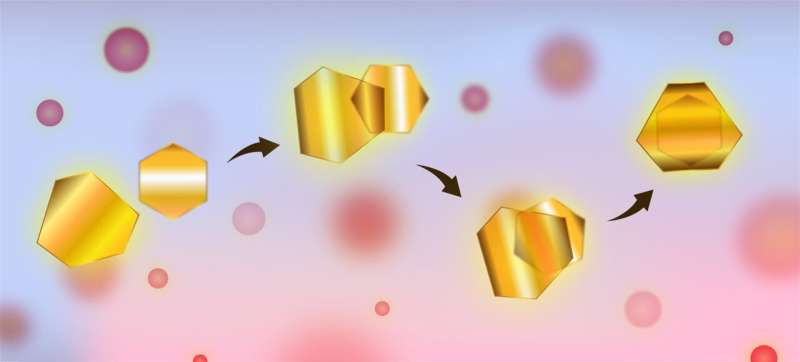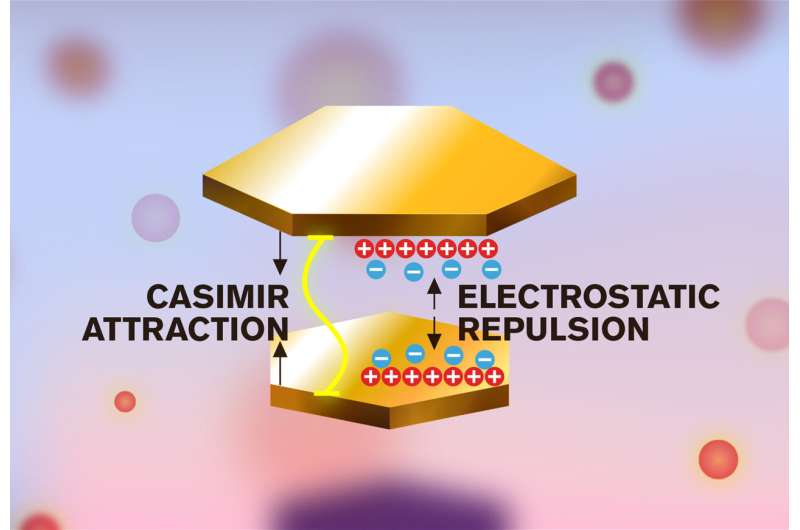Researchers at Chalmers University of Technology have discovered that two gold nanoflakes can connect to each other solely through naturally occurring forces, to form a versatile nanoscopic structure useful for exploring new physical phenomena. Credit: Chalmers University of Technology | Yen Strandqvist
For exploring materials down to the nano-level, researchers often need to construct a complex structure to house the materials—a time-consuming and complicated process. But imagine if there was a way the structure could simply build itself. That is exactly what researchers from Chalmers University of Technology, Sweden, now present in an article in the journal Nature.
Investigating nano materials reveals completely new properties and interactions. For such studies, different types of 'resonators' are often needed, objects inside which light bounces around, much the way sound bounces inside the body of a guitar. Now, researchers working at the Department of Physics at Chalmers University of Technology, have discovered how a previously known form of resonator made of two parallel mirrors can be created and controlled in a much simpler way than previously realized.
"Creating a high-quality, stable resonator, as we have done, is usually complicated and requires many hours in the laboratory. But here, we saw it happen of its own accord, reacting to naturally occurring forces, and requiring no external energy input. You could practically make our resonator in your own kitchen—it is created at room temperature, with ordinary water and a little salt," explains research leader Timur Shegai, associate professor in the Department of Physics, who was himself surprised by the nature of the discovery in the lab.
A self-assembling and growing system
What he and his colleagues observed is that when two tiny gold flakes—5000 nanometres in diameter and only 30 nanometres thick—meet in a salty aqueous solution, an interaction arises that causes them to form a pair. The two gold flakes are both positively charged as the aqueous solution covers them with double layers of ions. This causes a repelling electrostatic force, but, due to the simultaneous influence of the Casimir effect, an attracting force is also created and a stable balance arises, leaving a distance between the flakes of around 150 nanometres. The two nanoflakes orient themselves facing each other, with a cavity formed between them, and they remain stably in this arrangement for weeks of observations. The cavity then functions as an optical resonator, a device that provides many opportunities to explore various physical phenomena.
Once the gold flakes have formed a pair, they remain in place, and if not actively separated, more and more pieces of gold seek each other out and form a larger grouping. This means that the structure, purely through naturally occurring forces, can grow and create more interesting opportunities for researchers.
The structure can be further manipulated by adding more salt to the aqueous solution, changing the temperature, or by illuminating it with lasers, which can lead to some fascinating observations.
"What is so interesting in this case is that there are colors that appear inside the resonator. What we're seeing is basically self-assembled color. This combines a lot of interesting and fundamental physics, but at the same time, it's very easy to make. Sometimes, physics can be so surprising and so beautiful," says Timur Shegai.
When two tiny gold flakes meet in a salty aqueous solution, an interaction arises that causes them to form a pair. They are both positively charged as the aqueous solution covers them with double layers of ions (red and blue). This causes a repelling electrostatic force, but, due to the simultaneous influence of something called the "Casimir effect," an attracting force is also created, and a stable balance arises. The two nanoflakes orient themselves facing each other, with a cavity between them formed, and they remain stable in this arrangement for weeks of observations. This cavity then functions as an optical resonator, a device which offers a tunable system for studying combinations of light and matter known as polaritons. Credit: Chalmers University of Technology | Denis Baranov and Yen Strandqvist
Studying the meeting point between light and matter
The structure can then be used as a chamber for investigating materials and their behavior. By placing a two-dimensional material only a few atomic layers thick in the cavity or by making adjustments to the cavity, polaritons can also be created—hybrid particles that make it possible to study the meeting point between light and matter.
"Our structure can now be added to the overall toolbox of self-assembly methods. Thanks to its versatility, this could be used to study both basic and applied physics," says Battulga Munkhbat, post doc at the Department of Physics and first author of the article.
According to the study's authors, there are no obstacles to the structure being scaled up to use larger gold flakes that can be seen with the naked eye, which could open up even more possibilities.
"In the future, I could see this platform being used to study polaritons in a simpler way than is possible today. Another area could be to take advantage of the colors created between the gold flakes, for example in pixels, to create different kinds of RGB values, where each color could be checked for different combinations. There could also be applications in biosensors, optomechanics, or nanorobotics," says Timur Shegai.
The article, "Tunable self-assembled Casimir microcavities and polaritons," has been published in Nature.
More information: Battulga Munkhbat et al, Tunable self-assembled Casimir microcavities and polaritons, Nature (2021). DOI: 10.1038/s41586-021-03826-3
Journal information: Nature
Provided by Chalmers University of Technology

























